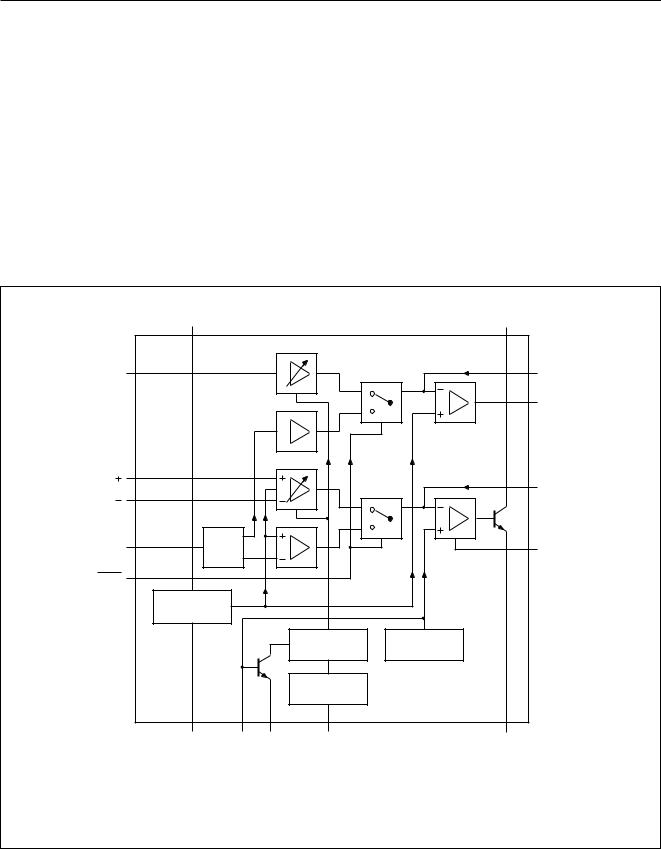Philips TEA1062T-C4, TEA1062T-C3, TEA1062A-C4-M1, TEA1062A-C4, TEA1062A-C3 Datasheet
...
INTEGRATED CIRCUITS
DATA SHEET
TEA1062; TEA1062A
Low voltage transmission circuits with dialler interface
Product specification |
1997 Sep 03 |
Supersedes data of 1996 Dec 04
File under Integrated Circuits, IC03

Philips Semiconductors |
Product specification |
|
|
Low voltage transmission circuits with
TEA1062; TEA1062A
dialler interface
FEATURES
∙Low DC line voltage; operates down to 1.6 V (excluding polarity guard)
∙Voltage regulator with adjustable static resistance
∙Provides a supply for external circuits
∙Symmetrical high-impedance inputs (64 kΩ) for dynamic, magnetic or piezoelectric microphones
∙Asymmetrical high-impedance input (32 kΩ) for electret microphones
∙DTMF signal input with confidence tone
∙Mute input for pulse or DTMF dialling
–TEA1062: active HIGH (MUTE)
–TEA1062A: active LOW (MUTE)
∙Receiving amplifier for dynamic, magnetic or piezoelectric earpieces
∙Large gain setting ranges on microphone and earpiece amplifiers
∙Line loss compensation (line current dependent) for microphone and earpiece amplifiers
∙Gain control curve adaptable to exchange supply
∙DC line voltage adjustment facility.
QUICK REFERENCE DATA
GENERAL DESCRIPTION
The TEA1062 and TEA1062A are integrated circuits that perform all speech and line interface functions required in fully electronic telephone sets. They perform electronic switching between dialling and speech. The ICs operate at line voltage down to 1.6 V DC (with reduced performance) to facilitate the use of more telephone sets connected in parallel.
All statements and values refer to all versions unless otherwise specified.
SYMBOL |
PARAMETER |
CONDITIONS |
MIN. |
TYP. |
MAX. |
UNIT |
||||
|
|
|
|
|
|
|
||||
VLN |
line voltage |
Iline = 15 mA |
3.55 |
4.0 |
4.25 |
V |
||||
Iline |
operating line current |
|
|
|
|
|
|
|
|
|
|
normal operation |
|
|
|
|
|
11 |
− |
140 |
mA |
|
with reduced performance |
|
|
|
|
|
1 |
− |
11 |
mA |
|
|
|
|
|
|
|
||||
ICC |
internal supply current |
VCC = 2.8 V |
− |
0.9 |
1.35 |
mA |
||||
VCC |
supply voltage for peripherals |
Iline = 15 mA |
|
|
|
|
||||
|
TEA1062 |
Ip = 1.2 mA; MUTE = HIGH |
2.2 |
2.7 |
− |
V |
||||
|
|
Ip = 0 mA; MUTE = HIGH |
− |
3.4 |
− |
V |
||||
|
|
|
|
|
|
|
− |
|
||
|
TEA1062A |
Ip = 1.2 mA; |
MUTE |
= LOW |
2.2 |
2.7 |
V |
|||
|
|
|
− |
|
− |
|
||||
|
|
Ip = 0 mA; |
MUTE |
= LOW |
3.4 |
V |
||||
Gv |
voltage gain |
|
|
|
|
|
|
|
|
|
|
microphone amplifier |
|
|
|
|
|
44 |
− |
52 |
dB |
|
receiving amplifier |
|
|
|
|
|
20 |
− |
31 |
dB |
|
|
|
|
|
|
|
|
|
|
|
Tamb |
operating ambient temperature |
|
|
|
|
|
−25 |
− |
+75 |
°C |
Line loss compensation |
|
|
|
|
|
|
|
|
|
|
|
|
|
|
|
|
|
|
|
|
|
Gv |
gain control |
|
|
|
|
|
− |
5.8 |
− |
dB |
Vexch |
exchange supply voltage |
|
|
|
|
|
36 |
− |
60 |
V |
Rexch |
exchange feeding bridge resistance |
|
|
|
|
|
0.4 |
− |
1 |
kΩ |
1997 Sep 03 |
2 |

Philips Semiconductors |
Product specification |
|
|
Low voltage transmission circuits with
TEA1062; TEA1062A
dialler interface
ORDERING INFORMATION
TYPE NUMBER |
|
PACKAGE |
|
|
|
|
|
||
NAME |
DESCRIPTION |
VERSION |
||
|
||||
|
|
|
|
|
TEA1062 |
DIP16 |
plastic dual in-line package; 16 leads (300 mil) |
SOT38-1 |
|
|
|
|
|
|
TEA1062M1 |
DIP16 |
plastic dual in-line package; 16 leads (300 mil) |
SOT38-4 or |
|
|
|
|
SOT38-9 |
|
|
|
|
|
|
TEA1062A |
DIP16 |
plastic dual in-line package; 16 leads (300 mil) |
SOT38-1 |
|
|
|
|
|
|
TEA1062AM1 |
DIP16 |
plastic dual in-line package; 16 leads (300 mil) |
SOT38-4 or |
|
|
|
|
SOT38-9 |
|
|
|
|
|
|
TEA1062T |
SO16 |
plastic small outline package; 16 leads; body width 3.9 mm |
SOT109-1 |
|
|
|
|
|
|
TEA1062AT |
SO16 |
plastic small outline package; 16 leads; body width 3.9 mm |
SOT109-1 |
|
|
|
|
|
BLOCK DIAGRAM
handbook, full pagewidth
(1)
|
VCC |
|
|
|
LN |
|
|
13 |
|
|
|
1 |
|
IR |
10 |
|
|
|
5 |
GAR |
|
|
|
|
|
||
|
|
TEA1062A |
|
|
4 |
QR |
|
|
|
|
|
||
MIC |
7 |
|
|
|
2 |
|
|
|
|
|
GAS1 |
||
|
6 |
|
|
|
|
|
MIC |
|
|
|
|
|
|
|
|
|
|
|
|
|
DTMF |
11 |
dB |
|
|
3 |
GAS2 |
|
|
|
|
|||
MUTE |
12 |
|
|
|
|
|
|
|
|
|
|
|
|
|
SUPPLY AND |
|
|
|
|
|
|
REFERENCE |
|
|
|
|
|
|
|
|
|
CONTROL |
LOW VOLTAGE |
|
|
|
|
|
CURRENT |
CIRCUIT |
|
|
|
|
|
CURRENT |
|
|
|
|
|
|
REFERENCE |
|
|
|
9 |
14 |
15 |
8 |
16 |
MBA359 - 1 |
|
VEE |
REG |
AGC |
STAB |
SLPE |
|
(1) Pin 12 is active HIGH (MUTE) for TEA1062.
Fig.1 Block diagram for TEA1062A.
1997 Sep 03 |
3 |

Philips Semiconductors |
Product specification |
|
|
Low voltage transmission circuits with
TEA1062; TEA1062A
dialler interface
PINNING
|
SYMBOL |
PIN |
DESCRIPTION |
|
|
|
|
|
|
|
LN |
1 |
positive line terminal |
|
|
|
|
|
|
|
GAS1 |
2 |
gain adjustment; transmitting |
|
|
|
|
|
amplifier |
|
|
|
|
|
|
GAS2 |
3 |
gain adjustment; transmitting |
|
|
|
|
|
amplifier |
|
|
|
|
|
|
QR |
4 |
non-inverting output; receiving |
|
|
|
|
|
amplifier |
|
|
|
|
|
|
GAR |
5 |
gain adjustment; receiving |
|
|
|
|
|
amplifier |
|
|
|
|
|
|
MIC− |
6 |
inverting microphone input |
|
|
|
|
|
|
|
MIC+ |
7 |
non-inverting microphone input |
|
|
|
|
|
|
|
STAB |
8 |
current stabilizer |
|
|
|
|
|
|
|
VEE |
9 |
negative line terminal |
|
|
IR |
10 |
receiving amplifier input |
|
|
|
|
|
|
|
DTMF |
11 |
dual-tone multi-frequency input |
|
|
|
|
||
|
|
|
12 |
mute input (see note 1) |
|
MUTE |
|
||
|
|
|
||
VCC |
13 |
positive supply decoupling |
||
REG |
14 |
voltage regulator decoupling |
||
|
|
|
||
AGC |
15 |
automatic gain control input |
||
|
|
|
||
SLPE |
16 |
slope (DC resistance) adjustment |
||
|
|
|
|
|
Note
1. Pin 12 is active HIGH (MUTE) for TEA1062.
handbook, halfpage
LN |
1 |
|
16 |
SLPE |
|||||||
|
|
|
|
|
|
|
|
|
AGC |
||
GAS1 |
2 |
|
|
15 |
|||||||
|
|
|
|
|
|
|
|
|
|
|
|
GAS2 |
3 |
|
|
14 |
REG |
||||||
QR |
|
|
|
|
VCC |
||||||
4 |
13 |
||||||||||
GAR |
|
|
TEA1062A |
|
|
|
|||||
5 |
|
|
12 |
MUTE |
|||||||
MIC |
|
|
|
|
|
|
|
|
DTMF |
||
|
|
6 |
|
|
11 |
||||||
|
|||||||||||
MIC |
|
|
|
|
|
|
|
|
IR |
||
|
|
|
|
7 |
|
|
10 |
||||
STAB |
|
|
|
|
VEE |
||||||
8 |
9 |
||||||||||
|
|
|
|
|
|
|
|
|
|
|
|
|
|
|
|
|
|
|
MBA354 - 1 |
|
|
||
Fig.2 Pin configuration for TEA1062A.
1997 Sep 03 |
4 |

Philips Semiconductors |
Product specification |
|
|
Low voltage transmission circuits with
TEA1062; TEA1062A
dialler interface
FUNCTIONAL DESCRIPTION
Supplies VCC, LN, SLPE, REG and STAB
Power for the IC and its peripheral circuits is usually obtained from the telephone line. The supply voltage is derived from the line via a dropping resistor and regulated by the IC. The supply voltage VCC may also be used to supply external circuits e.g. dialling and control circuits.
Decoupling of the supply voltage is performed by a capacitor between VCC and VEE. The internal voltage regulator is decoupled by a capacitor between REG and VEE.
The DC current flowing into the set is determined by the exchange supply voltage Vexch, the feeding bridge
resistance Rexch and the DC resistance of the telephone line Rline.
The circuit has an internal current stabilizer operating at a level determined by a 3.6 kΩ resistor connected between
STAB and VEE (see Fig.9). When the line current (Iline) is more than 0.5 mA greater than the sum of the IC supply
current (ICC) and the current drawn by the peripheral circuitry connected to VCC (Ip) the excess current is shunted to VEE via LN.
The regulated voltage on the line terminal (VLN) can be calculated as:
VLN = Vref + ISLPE × R9
VLN = Vref + {(Iline − ICC − 0.5 × 10−3 A) − Ip} × R9
Vref is an internally generated temperature compensated reference voltage of 3.7 V and R9 is an external resistor connected between SLPE and VEE.
In normal use the value of R9 would be 20 Ω.
Changing the value of R9 will also affect microphone gain, DTMF gain, gain control characteristics, sidetone level, maximum output swing on LN and the DC characteristics (especially at the lower voltages).
Under normal conditions, when ISLPE >> ICC + 0.5 mA + Ip, the static behaviour of the circuit is that of a 3.7 V regulator
diode with an internal resistance equal to that of R9. In the audio frequency range the dynamic impedance is largely determined by R1. Fig.3 shows the equivalent impedance of the circuit.
LN handbook, halfpage
Leq |
R p |
R1 |
V ref |
REG |
VCC |
R9 |
C3 |
C1 |
20 Ω |
4.7 μF |
100 μF |
VEE |
|
MBA454 |
Leq = C3 × R9 × Rp.
Rp = 16.2 kΩ.
Fig.3 Equivalent impedance circuit.
At line currents below 9 mA the internal reference voltage is automatically adjusted to a lower value (typically 1.6 V at 1 mA). This means that more sets can be operated in parallel with DC line voltages (excluding the polarity guard) down to an absolute minimum voltage of 1.6 V. At line currents below 9 mA the circuit has limited sending and receiving levels. The internal reference voltage can be adjusted by means of an external resistor (RVA).
This resistor when connected between LN and REG will decrease the internal reference voltage and when connected between REG and SLPE will increase the internal reference voltage.
Current (Ip) available from VCC for peripheral circuits depends on the external components used. Fig.10 shows this current for VCC > 2.2 V. If MUTE is LOW (TEA1062) or
MUTE is HIGH (TEA1062A) when the receiving amplifier is driven, the available current is further reduced. Current availability can be increased by connecting the supply IC (TEA1081) in parallel with R1 as shown in Fig.19 and Fig.20, or by increasing the DC line voltage by means of an external resistor (RVA) connected between REG and SLPE (Fig.18).
1997 Sep 03 |
5 |

Philips Semiconductors |
Product specification |
|
|
Low voltage transmission circuits with
TEA1062; TEA1062A
dialler interface
Microphone inputs MIC+ and MIC− and gain pins
GAS1 and GAS2
The circuit has symmetrical microphone inputs. Its input impedance is 64 kΩ (2 × 32 kΩ) and its voltage gain is typically 52 dB (when R7 = 68 kΩ, see Figures 14
and 15). Dynamic, magnetic, piezoelectric or electret (with built-in FET source followers) can be used. Microphone arrangements are illustrated in Fig.11.
The gain of the microphone amplifier can be adjusted between 44 dB and 52 dB to suit the sensitivity of the transducer in use. The gain is proportional to the value of R7 which is connected between GAS1 and GAS2.
Stability is ensured by two external capacitors, C6 connected between GAS1 and SLPE and C8 connected between GAS1 and VEE. The value of C6 is 100 pF but this may be increased to obtain a first-order low-pass filter. The value of C8 is 10 times the value of C6. The cut-off frequency corresponds to the time constant R7 × C6.
Input MUTE (TEA1062)
When MUTE is HIGH the DTMF input is enabled and the microphone and receiving amplifier inputs are inhibited. The reverse is true when MUTE is LOW or open-circuit. MUTE switching causes only negligible clicking on the line and earpiece output. If the number of parallel sets in use causes a drop in line current to below 6 mA the speech amplifiers remain active independent to the DC level applied to the MUTE input.
Input MUTE (TEA1062A)
When MUTE is LOW or open-circuit, the DTMF input is enabled and the microphone and receiving amplifier inputs are inhibited. The reverse is true when MUTE is HIGH. MUTE switching causes only negligible clicking on the line and earpiece output. If the number of parallel sets in use causes a drop in line current to below 6 mA the DTMF amplifier becomes active independent to the DC level applied to the MUTE input.
Dual-tone multi-frequency input DTMF
When the DTMF input is enabled dialling tones may be sent on to the line. The voltage gain from DTMF to LN is typically 25.5 dB (when R7 = 68 kΩ) and varies with R7 in the same way as the microphone gain. The signalling tones can be heard in the earpiece at a low level (confidence tone).
Receiving amplifier IR, QR and GAR
The receiving amplifier has one input (IR) and a non-inverting output (QR). Earpiece arrangements are illustrated in Fig.12. The IR to QR gain is typically 31 dB (when R4 = 100 kΩ). It can be adjusted between
20 and 31 dB to match the sensitivity of the transducer in use. The gain is set with the value of R4 which is connected between GAR and QR. The overall receive gain, between LN and QR, is calculated by subtracting the anti-sidetone network attenuation (32 dB) from the amplifier gain. Two external capacitors, C4 and C7, ensure stability. C4 is normally 100 pF and C7 is 10 times the value of C4. The value of C4 may be increased to obtain a first-order low-pass filter. The cut-off frequency will depend on the time constant R4 × C4.
The output voltage of the receiving amplifier is specified for continuous-wave drive. The maximum output voltage will be higher under speech conditions where the peak to RMS ratio is higher.
Automatic Gain Control input AGC
Automatic line loss compensation is achieved by connecting a resistor (R6) between AGC and VEE.
The automatic gain control varies the gain of the microphone amplifier and the receiving amplifier in accordance with the DC line current. The control range is 5.8 dB which corresponds to a line length of 5 km for a 0.5 mm diameter twisted-pair copper cable with a DC resistance of 176 Ω/km and average attenuation of
1.2 dB/km). Resistor R6 should be chosen in accordance with the exchange supply voltage and its feeding bridge resistance (see Fig.13 and Table 1). The ratio of start and stop currents of the AGC curve is independent of the value of R6. If no automatic line-loss compensation is required the AGC pin may be left open-circuit. The amplifiers, in this condition, will give their maximum specified gain.
1997 Sep 03 |
6 |

Philips Semiconductors |
Product specification |
|
|
Low voltage transmission circuits with
TEA1062; TEA1062A
dialler interface
Sidetone suppression
The anti-sidetone network, R1//Zline, R2, R3, R8, R9 and Zbal, (see Fig.4) suppresses the transmitted signal in the
earpiece. Maximum compensation is obtained when the following conditions are fulfilled:
R9 ´ R2 = R1 |
æ |
R8 ´ Zbal |
ö |
(1) |
´ ç R3 |
+ ------------------------ |
÷ |
||
|
è |
R8 + Zbal |
ø |
|
Zbal |
Zline |
|
(2) |
|
Z------------------------bal + R8 |
= -------------------------Zline + R1 |
|
||
If fixed values are chosen for R1, R2, R3 and R9, then condition (1) will always be fulfilled when |R8//Zbal| << R3.
To obtain optimum sidetone suppression, condition (2) has to be fulfilled which results in:
Z |
|
R8 |
´ Z |
|
= k ´ Z |
|
bal |
= ------- |
line |
line |
|||
|
R1 |
|
|
R8
Where k is a scale factor; k = -------
R1
The scale factor k, dependent on the value of R8, is chosen to meet the following criteria:
·compatibility with a standard capacitor from the E6 or E12 range for Zbal
·ïZbal//R8ï << R3 fulfilling condition (a) and thus ensuring correct anti-sidetone bridge operation
·ïZbal + R8ï >> R9 to avoid influencing the transmit gain.
In practise Zline varies considerably with the line type and length. The value chosen for Zbal should therefore be for
an average line length thus giving optimum setting for short or long lines.
EXAMPLE
The balance impedance Zbal at which the optimum suppression is present can be calculated by:
Suppose Zline = 210 W + (1265 W//140 nF) representing a 5 km line of 0.5 mm diameter, copper, twisted-pair cable matched to 600 W (176 W/km; 38 nF/km).
When k = 0.64 then R8 = 390 W;
Zbal = 130 W + (820 W//220 nF).
The anti-sidetone network for the TEA1060 family shown in Fig.4 attenuates the signal received from the line by 32 dB before it enters the receiving amplifier.
The attenuation is almost constant over the whole audio-frequency range.
Figure 5 shows a conventional Wheatstone bridge anti-sidetone circuit that can be used as an alternative. Both bridge types can be used with either resistive or complex set impedances. (More information on the balancing of anti-sidetone bridges can be obtained in our publication “Applications Handbook for Wired telecom systems, IC03b”, order number 9397 750 00811.)
1997 Sep 03 |
7 |

Philips Semiconductors |
Product specification |
|
|
Low voltage transmission circuits with
TEA1062; TEA1062A
dialler interface
|
LN |
handbook, full pagewidth |
|
R1 |
R2 |
Zline |
|
|
IR |
VEE |
im |
Rt |
R3
R9
R8
Zbal
SLPE
MSA500 - 1
Fig.4 Equivalent circuit of TEA1060 family anti-sidetone bridge.
ook, full pagewidth |
LN |
|
|
|
|
R1 |
Zbal |
|
|
Zline |
|
|
|
|
im |
IR |
|
VEE |
Rt |
||
|
|||
R9 |
R8 |
RA |
|
|
|
||
|
SLPE |
|
|
|
|
MSA501 - 1 |
Fig.5 Equivalent circuit of an anti-sidetone network in a Wheatstone bridge configuration.
1997 Sep 03 |
8 |

Philips Semiconductors |
Product specification |
|
|
Low voltage transmission circuits with
TEA1062; TEA1062A
dialler interface
LIMITING VALUES
In accordance with the Absolute Maximum Rating System (IEC 134).
SYMBOL |
PARAMETER |
CONDITIONS |
MIN. |
MAX. |
UNIT |
|
|
|
|
|
|
VLN |
positive continuous line voltage |
|
− |
12 |
V |
VLN(R) |
repetitive line voltage during switch-on |
|
− |
13.2 |
V |
|
or line interruption |
|
|
|
|
|
|
|
|
|
|
VLN(RM) |
repetitive peak line voltage for a 1 ms |
R9 = 20 Ω; R10 = 13 Ω; |
− |
28 |
V |
|
pulse per 5 s |
see Fig.18 |
|
|
|
|
|
|
|
|
|
Iline |
line current |
R9 = 20 Ω; note 1 |
− |
140 |
mA |
VI |
input voltage on all other pins |
positive input voltage |
− |
VCC + 0.7 |
V |
|
|
negative input voltage |
− |
−0.7 |
V |
|
|
|
|
|
|
Ptot |
total power dissipation |
R9 = 20 Ω; note 2 |
|
|
|
|
TEA1062; TEA1062A |
|
− |
666 |
mW |
|
TEA1062M1; TEA1062AM1 |
|
− |
617 |
mW |
|
TEA1062T; TEA1062AT |
|
− |
454 |
mW |
|
|
|
|
|
|
Tamb |
operating ambient temperature |
|
−25 |
+75 |
°C |
Tstg |
storage temperature |
|
−40 |
+125 |
°C |
Tj |
junction temperature |
|
− |
125 |
°C |
Notes
1.Mostly dependent on the maximum required Tamb and on the voltage between LN and SLPE (see Figs 6, 7 and 8).
2.Calculated for the maximum ambient temperature specified (Tamb = 75 °C) and a maximum junction temperature of 125 °C.
HANDLING
This device meets class 2 ESD test requirements [Human Body Model (HBM)], in accordance with
“MIL STD 883C - method 3015”.
THERMAL CHARACTERISTICS
SYMBOL |
PARAMETER |
VALUE |
UNIT |
|
|
|
|
Rth j-a |
thermal resistance from junction to ambient in free air |
|
|
|
TEA1062; TEA1062A |
75 |
K/W |
|
TEA1062M1; TEA1062AM1 |
81 |
K/W |
|
TEA1062T; TEA1062AT (note 1) |
110 |
K/W |
|
|
|
|
Note
1. Mounted on glass epoxy board 28.5 × 19.1 × 1.5 mm.
1997 Sep 03 |
9 |
